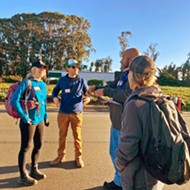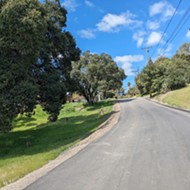[{
"name": "Newsletter Promo",
"id": "NewsletterPromo",
"class": "inlineCenter",
"insertPoint": "4",
"component": "15264767",
"requiredCountToDisplay": "0"
},{
"name": "Ad - Medium Rectangle CC01 - 300x250",
"id": "AdMediumRectangleCC01300x250",
"class": "inlineCenter",
"insertPoint": "8",
"component": "2963441",
"requiredCountToDisplay": "12"
},{
"name": "Ad - Medium Rectangle LC01 - 300x250",
"id": "AdMediumRectangleCC01300x250",
"class": "inlineCenter",
"insertPoint": "18",
"component": "2963441",
"requiredCountToDisplay": "22"
},{
"name": "Ad - Medium Rectangle LC09 - 300x250",
"id": "AdMediumRectangleLC09300x250",
"class": "inlineCenter",
"insertPoint": "28",
"component": "3252660",
"requiredCountToDisplay": "32"
}]
SLO County residents could see a transportation sales tax on general election ballot if the SLO Council of Governments (SLOCOG) votes to pass a countywide self-help sales tax measure and transportation investment plan.
Currently in the drafting process, the transportation investment plan (TIP) proposes a half-cent transportation sales tax measure that would generate $35 million region-wide over the next 20 years, resulting in $700 million back to SLO's economy to help with community road safety and congestion improvements, SLOCOG Deputy Director James Worthley told New Times.
To put the half-cent transportation sales tax into perspective, Worthley said, it would equal 50 cents per $100 of taxable goods.
Funds would then be distributed to four subregions within SLO County: North County, South County, Central County, and North Coast, with each of these subregions receiving 66 percent of the funds for local projects and the remaining 34 percent will be allocated to regional projects within each subregion, according to a March 11 Grover Beach staff report.
SLOCOG has already met with the San Luis Obispo, Grover Beach, and Arroyo Grande city councils to hear reviews, advice, and public comments from council and community members. But it still has to meet with Pismo Beach, Atascadero, Paso Robles, and Morro Bay before presenting it to the SLO County Board of Supervisors on April 9.
Worthley told New Times that these meetings have been challenging so far.
"One city came back very strong and supported and identified all kinds of reasons why this is going to be important to our region, another one was warm to the idea because they could see the benefits to complete projects in their community, and then the third, I would say was pretty cold," he said. "Probably because they're considering a sales tax on their own and their concern would be that this measure would complete with their measure."
During the March 5 SLO City Council meeting, resident Leah Brooks said that she supported SLOCOG's previous sale tax attempt and was disappointed when it didn't pass.
"The city of San Luis is making so many positive changes to our transportation system, and, you know, as a bicyclist and pedestrian, it's just wonderful to be protected from some of these motorists," she said during public comment.
In 2016, SLO County voters narrowly rejected Measure J, a half-percent sales tax measure for transportation revenue, according to previous New Times reporting.
Grover Beach residents expressed concerns about the possibility of a new tax during a March 11 City Council meeting.
Resident David Swift asked the council why they don't tax their citizens locally, which would keep the money local if they want road repairs.
"I just did some quick math, and it looks like you are proposing taxing the citizens a half a percent to send the money away and get back a sixth of that half percent," he told Worthley and the council. "So not only are we donating in taxes, we're donating it to someplace else. So, keep the money local and you can tax us a third of the percent and have the same money returned to you without having to send it to someplace else."
In Arroyo Grande, Mayor Caren Ray Russom brought up similar concerns during the March 12 City Council meeting, claiming that Arroyo Grande had been discussing adding its own local sales tax to the November ballot.
"You know you're in competition with us, because we're trying to decide what we're going to do about this and if we're going to ask our own citizens to support our own measure," she said.
Worthley told New Times that if Arroyo Grande does decide to propose their own sales tax, it wouldn't be a competition and the two sales taxes could be complementary to each other.
"There's not enough money going to roads currently. Our measure would require a two-thirds vote to approve it and that's what makes it a special or specific tax," he said. "Once that is approved, it's locked in place and that is guaranteed for transportation as laid out to voters in the investment plan."
However, this tax measure has a long way to go before it hits the November ballot. Worthley said after the Board of Supervisors weighs in, SLOCOG's board will review the collected community input and make necessary changes.
Then it would need to go back to the Board of Supervisors and cities for approval before returning to the SLOCOG board for final approval before it can be added to the November ballot. Δ
Latest in News
Readers also liked…
-

Coast Unified teachers upset over new position's salary and qualifications
Oct 20, 2022 -

SLO police identify alleged driver who hit and killed couple
Dec 22, 2022 -

When the levee breaks: Oceano residents, county officials walk a tightrope of regulations to manage Arroyo Grande Creek, which some say led to the levee's failure in January
May 18, 2023









